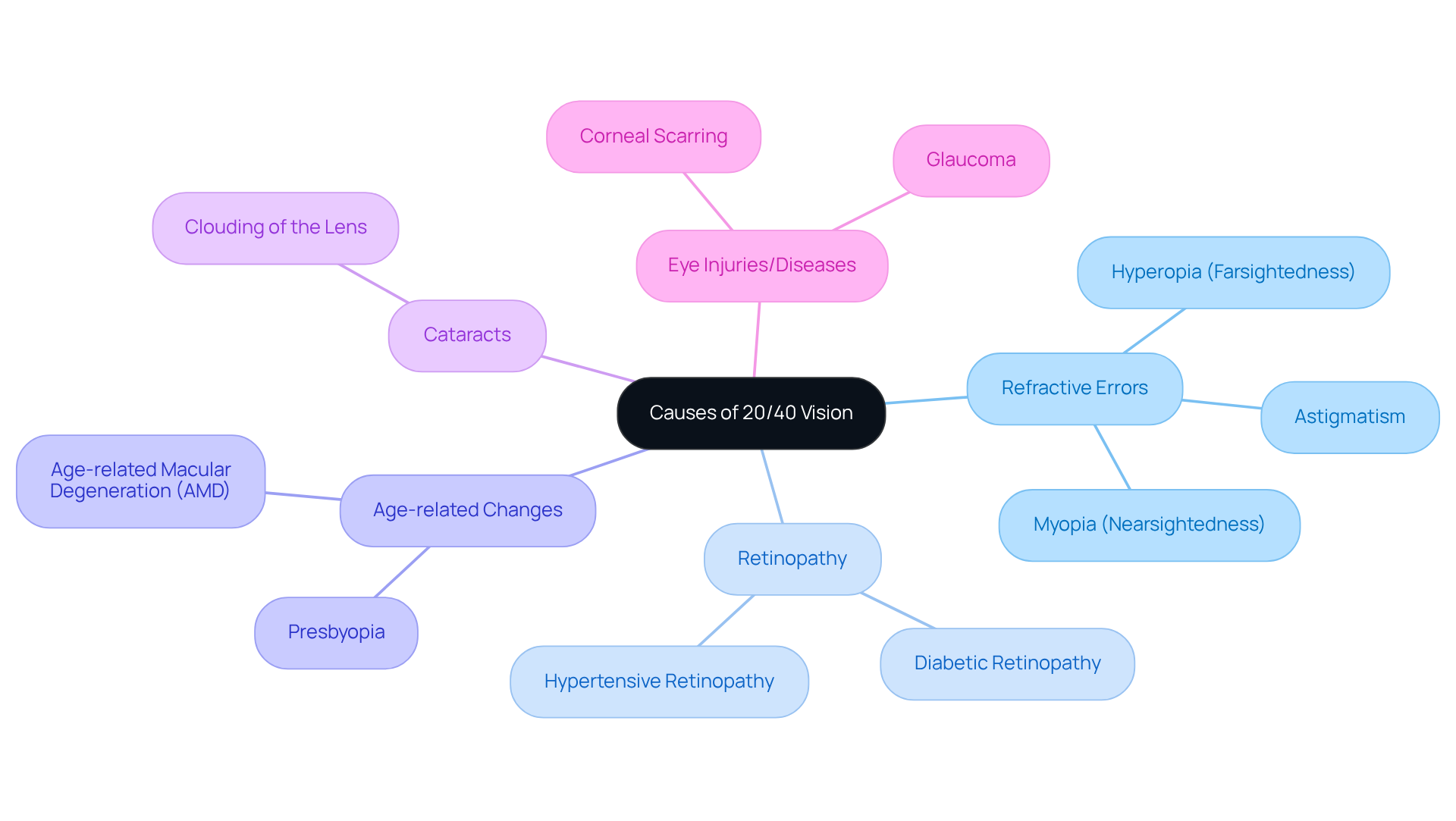Posted by: Northwest Eye in General on November 10, 2025
Overview
20/40 vision can feel concerning, and it’s important to understand what it means. This measure of visual acuity indicates that you can see at 20 feet what someone with normal vision can see at 40 feet. It’s common for many people, often due to refractive errors or age-related conditions, and it can impact daily activities like driving and reading.
We understand that dealing with vision changes can be challenging. The good news is that there are several corrective options available to help improve clarity and enhance your quality of life.
- Glasses and contact lenses are popular choices.
- Many people find success with surgical procedures like LASIK.
If you’re feeling uncertain about your vision, know that you’re not alone. Many have walked this path and found reassurance through treatment. We are here to help you through this process, providing support and guidance every step of the way. Remember, taking action towards better vision can lead to a brighter, clearer future.
Introduction
Understanding your vision is crucial in navigating daily life. We know that visual acuity measurements, like 20/40 vision, can feel overwhelming. This specific level of sight means you can see at 20 feet what someone with normal vision can see at 40 feet. It’s common to feel concerned about the potential challenges this may bring, especially in activities like driving and reading.
Did you know that approximately 20% of the population experiences this level of vision? This raises important questions about quality of life and the options available for correction. We understand that you might be wondering what steps you can take to enhance your visual clarity and address the limitations that come with 20/40 vision.
It’s important to know that there are ways to improve your situation. Whether it’s through corrective lenses, vision therapy, or other options, support is available. We are here to help you through this process and ensure you feel confident in your choices.
Define 20/40 Vision: A Clear Understanding
20 40 vision is a specific measure of clarity that indicates how well you can see at a distance. It means that with 20 40 vision, at 20 feet you can see what someone with standard eyesight (20/20) can see at 40 feet. This assessment is often used in eye exams to evaluate visual clarity.
We understand that having moderate eyesight can be concerning. While it’s not classified as significant impairment, it may mean you have some difficulty seeing distant objects clearly. This can affect daily activities like driving, reading road signs, or watching television. In fact, studies suggest that around 20% of people may have eyesight classified as 20 40 vision or lower, which highlights how common this is.
Many individuals adapt to this level of sight, but it’s important to know that corrective measures, such as glasses or contact lenses, can greatly enhance clarity and improve your quality of life. Understanding the effects of impaired sight is crucial, especially when it comes to making decisions about driving safety and the need for corrective lenses.
Routine eye check-ups are essential for assessing your eyesight sharpness and managing any changes in your eye health. We are here to help you through this process, ensuring you have the support and information you need.

Explore the Implications of 20/40 Vision on Daily Life
Many people with moderate eyesight encounter specific challenges in their daily lives. For instance, reading road signs while driving or recognizing faces from a distance can be quite tough. While this level of visual sharpness allows many to perform everyday tasks, it might not meet the legal requirements for driving in certain areas, where a minimum of 20/40 vision is typically necessary.
We understand that individuals with 20/40 vision may experience eye strain or fatigue, especially during prolonged activities like reading or using digital devices. In fact, studies show that about 2 to 3 percent of drivers may have eyesight below the minimum legal standards, highlighting how common eye problems can be among drivers.
It’s important to recognize these implications, as they can help you make informed decisions about your eye health. Considering corrective measures, such as glasses, contact lenses, or even LASIK, can significantly enhance your visual clarity and overall quality of life. Routine eye examinations are essential too; they help monitor changes in your vision and ensure optimal eye health.
We are here to help you through this process, and we encourage you to take proactive steps towards better eye care.

Identify the Causes of 20/40 Vision
A measurement of 20/40 vision can occur for various reasons, and we understand how concerning this can be. Often, it’s due to refractive errors like myopia (nearsightedness) and hyperopia (farsightedness). These conditions occur when the shape of the eye prevents light from focusing directly on the retina, leading to unclear vision.
For instance, nearly 900,000 Americans face challenges like retinopathy, which can also contribute to sight impairment and may result in 20/40 vision. It’s common to feel worried about age-related changes, especially presbyopia, which typically begins around age 40 and affects the ability to focus on close objects, complicating clarity even further.
Cataracts, characterized by clouding of the eye’s lens, are another frequent cause of diminished vision, impacting daily activities. Additionally, eye injuries or diseases can lead to decreased visual acuity. Understanding these factors is crucial for recognizing the right treatment options. Many people have successfully improved their vision from a moderate level to 20/15 through focused measures. For example, one patient enhanced their vision from a moderate level to 20/15 in just three months by following specific corrective measures.
At Northwest Eye, our specialists emphasize the importance of regular eye examinations to monitor these conditions. They can suggest corrective options, such as glasses or contact lenses, to improve clarity of sight and enhance your overall quality of life.
It’s also important to note that many states in the U.S. require a minimum level of eyesight, specifically 20/40 vision, for an unrestricted driver’s license, highlighting the practical implications of this degree of visual sharpness. As Dr. Marcie Nichols wisely states, “Whether you’re managing a specific level of eyesight or simply interested in your eye health, expert advice can guide you to solutions that create a significant impact.” We are here to help you through this process.

Examine Correction Options for 20/40 Vision
If you’re experiencing 20/40 vision, you might be wondering about your options for correction. We understand that this can be a challenging experience, and it’s important to know that there are several paths you can take, each with its own unique benefits.
Eyeglasses are often the simplest solution. They provide prescription lenses that effectively focus light onto your retina, helping you see clearly. If you’re looking for something a bit more discreet, contact lenses might be the right choice for you. They offer the freedom to move without the bulk of frames, allowing you to enjoy your daily activities with ease.
For those who desire a more permanent fix, surgical options like LASIK and cataract surgery can lead to significant improvements in visual acuity. LASIK reshapes the cornea to enhance focus, while cataract surgery replaces the cloudy lens with an artificial one, often restoring eyesight to 20/20 or even better. The success rate for LASIK is impressive, with over 99% of patients achieving 20/40 vision or better. Many patients express satisfaction with their outcomes, which is truly heartening.
Consider the stories of individuals like Thomas, who transitioned from glasses to sharp sight after LASIK, and Judith, who regained 20/20 clarity following cataract surgery. Their experiences highlight the transformative impact these procedures can have on your life.
At Northwest Eye, we offer innovative options like the Light Adjustable Lens (LAL), which responds to UV light and allows for post-surgery adjustments tailored to your lifestyle. This personalized approach to eyesight correction ensures that you receive care that fits your unique needs.
We encourage you to reach out for a personalized consultation. Our eye care professionals are here to help you navigate your options and determine the most suitable choice for your vision correction journey. Remember, you’re not alone in this process—we’re here to support you every step of the way.
Conclusion
Understanding 20/40 vision is essential for recognizing how it can impact daily life and overall well-being. We understand that this level of visual acuity means you can perform many tasks, but you might struggle with activities requiring sharper distance vision, like driving or reading road signs. By acknowledging the nuances of 20/40 vision, you can make informed decisions about your eye health and explore corrective options available to enhance your visual clarity.
This article highlights several key aspects of 20/40 vision, including its definition and common causes such as refractive errors and age-related changes. It also discusses the potential effects on daily activities. We emphasize the importance of routine eye examinations and explore various correction options, from glasses and contact lenses to surgical interventions like LASIK and cataract surgery. Each of these solutions offers unique benefits, allowing you to improve your quality of life significantly.
Ultimately, proactive engagement with eye care can lead to substantial improvements in vision and life quality. Whether you’re considering corrective lenses or exploring surgical options, taking steps to address 20/40 vision can empower you to navigate your daily life more effectively. It’s common to feel uncertain about these choices, but prioritizing your eye health and seeking professional guidance can ensure the best possible outcomes for vision correction and overall well-being. We are here to help you through this process.
Frequently Asked Questions
What does 20/40 vision mean?
20/40 vision means that at a distance of 20 feet, you can see what a person with standard eyesight (20/20) can see at 40 feet. It is a measure of visual clarity.
Is 20/40 vision considered a significant impairment?
No, 20/40 vision is not classified as significant impairment. However, it may indicate some difficulty in seeing distant objects clearly.
How common is 20/40 vision among the population?
Studies suggest that around 20% of people may have eyesight classified as 20/40 vision or lower, indicating that it is relatively common.
What daily activities might be affected by 20/40 vision?
Individuals with 20/40 vision may experience difficulties with activities such as driving, reading road signs, or watching television.
What corrective measures can improve 20/40 vision?
Corrective measures such as glasses or contact lenses can greatly enhance clarity and improve quality of life for individuals with 20/40 vision.
Why are routine eye check-ups important?
Routine eye check-ups are essential for assessing eyesight sharpness and managing any changes in eye health, ensuring you have the support and information needed for your vision.






